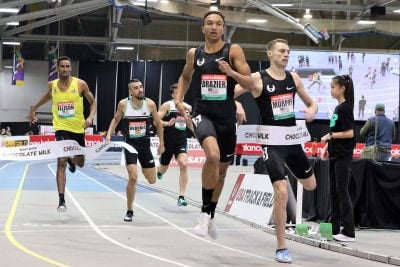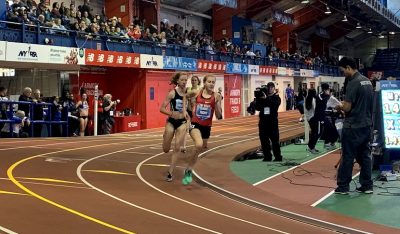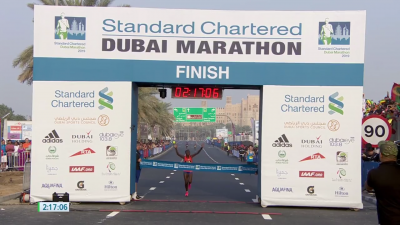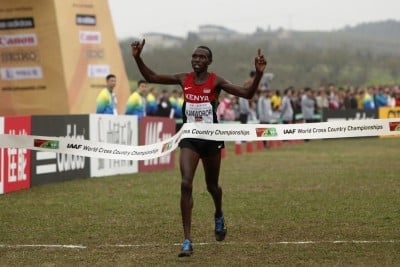Week That Was: Brazier AND Murphy Impress, Should We Not Get Excited About Fast HS Girls?, Who are the World XC Favorites?
The Week That Was in Running, January 21 – 27, 2019
By LetsRun.com
January 29, 2019
Past editions of the Week That Was can be found here.
Questions, comments, or a tip? Please call us at 844-LETSRUN (538-7786), email us, or post on our forum.
If you missed our coverage during the week regarding the Dubai Marathon, the New Balance Indoor Grand Prix, and the Dr. Sander Invite, please catch up now:
- 2019 Standard Chartered Dubai Marathon full coverage
- 2019 New Balance Indoor Grand Prix full coverage
- 2019 Dr Sander Invitational recap
*****
Donavan Brazier tries to learn something Alan Webb never did — how to run in a pack; Clayton Murphy tries to learn to do what Nick Symmonds never could — run from the front
If you are a US 800-meter fan, you had a GREAT weekend. Seriously, there were three really good things that happened last week.
In Boston at the New Balance Indoor Grand Prix, Donavan Brazier beat Clayton Murphy, 1:45.91 to 1:45.94, but the fact that Brazier beat Murphy was largely irrelevant to us as the race was very close. What was important was HOW the race unfolded.
-
The fact that Murphy front-ran himself to an indoor PR really got us excited. In the past, Murphy was pretty much a one-trick pony. He liked to come from behind. When you are an Olympic bronze medallist, that’s fine and dandy as normally he can kick himself to advancement or a good result. But sometimes, you don’t want to risk it. Sometimes it’s easier to run up front with no traffic, where you can’t get boxed in and your odds of falling are greatly reduced. We’ve always said the safest place to be in an 800 is the very front or very back. Plus if you are in a stacked heat, it’s good to be able to front-run to make sure some time qualifiers come from your heat.
Remember last year at USA Indoors, when Murphy didn’t get out of the first round as he played sit and kick with Drew Windle and Windle took the lone auto spot? Or the 2016 Olympics, when Murphy was fortunate to get out of the first round as he ran into a lot of traffic in his heat and only finished 4th?
Running from the front probably isn’t the best way for Murphy to win a race, but it’s a vital tactic for him to learn. It’s important to have as many tactical options at your disposal, particularly for 800 runners as the cutdown from 24 people at the semifinal stage to an 8-person final at a global champs is the toughest in the sport. Let’s say Murphy gets in a semi with David Rudisha and Emmanuel Korir at Worlds. Should he really be willing to let it come down to a kick? (Note: this tactic also doomed Ajee’ Wilson at the 2016 Olympics). Or does he want to make sure the heat is fast enough that at least three guys advance?
- Conversely, the fact that Brazier ran from behind to win the race in Boston on Saturday also really excited us. Before Saturday, Brazier was known as someone who either ran at the front or sat in second directly behind the leader. Now he’s learning how to run in a pack. While Brazier did sit on Murphy in second for most of the race on Saturday, he had no problem getting passed at the bell by Saul Ordonez, biding his time before making his winning move coming off the final turn. We think he should work on this ALL year long. It was something Alan Webb never quite mastered and something young runners need to learn when the stakes are modest. If anything, Brazier could have been more patient. You don’t really need to try to pass on the final turn (particularly indoors) if you are in second as you end up running a lot of extra ground. Just wait until you hit the homestretch and then try to kick for the win.
One thing did disturb us about Brazier’s race however. It was what he said after the race.
When asked Brazier about his tactics, Brazier replied, “I tried it, it worked out. I don’t know if I’ll do it again.” What? Yes, we know running 1:45.94 indoors might not be as impressive for Brazier as it is for others — remember, he opened up his collegiate career with a solo 1:45.93 in 2016, but Brazier definitely needs to keep practicing these tactics, even if front-running remains his preferred strategy. He needs to get comfortable running in the pack. End of story.
3. The third thing that excited us about last week was that neither Brazier nor Murphy was the fastest American last week. Texas A&M junior Devin Dixon DESTROYED Derek Peterson‘s American collegiate indoor record of 1:45.88, which had stood for nearly 20 years, by running 1:45.27 to move to #3 all-time on the US and NCAA list.
The US may not be the equal of Kenya at 800 quite yet (Kenya produced 6 of the 10 men who broke 1:44 last year), but there is a lot of young talent in the event right now as Brazier (21), Isaiah Harris (22), Murphy (23), Windle (26), and Boris Berian (26) are all under the age of 27.
MB: Devin Dixon of Texas A&M DESTROYS American collegiate record – runs 1:45.27 – at altitude!!
****
Two high school girls run super fast, but we’ll feel more comfortable leading the hype train in a few years
Last weekend, there were two additions to the top 10 of the US high school girls’ indoor 3000m list. New York junior Katelyn Tuohy moved to #1 with a 9:01.81 at the Armory and Pennsylvania junior Marlee Starliper cracked the top 10 at #8 with a 9:20.91 win over collegians at Penn State.
Congrats to both, but we aren’t going to talk about them at all here other than to remind everyone that getting excited about teenage girls’ performances is a dangerous thing for running fans to do. A safer mantra for the larger running community is to think, “If they PR after their teenage years are over, then I’ll get excited.” (Obviously the girls themselves and their families/teammates/coaches should be excited with every PR).
One doesn’t have to be a longtime follower of the sport to realize this. Just look at the two women who sit just behind Tuohy on the all-time 3000 list. Previous record holder Mary Cain (9:04.51 in 2013), now 22, hasn’t finished a race in more than two years. Kate Murphy (#3 at 9:14.12 in 2017), 19, has already retired from collegiate running after her freshman year at Oregon.
If you are looking for an even more recent reason to be cautious, there was actually one last week in the aborted comeback of Claudia Lane, the 2016 and 2017 Foot Locker champ who missed the 2018 XC season with injury. Lane, who has a 10:01 2-mile best, didn’t even make it 800 meters at well over 5-minute pace in an indoor mile in Virginia.
****
Dubai does it again
While the prize money was reduced in Dubai this year, the performances were elevated as course records fell on both the men’s and women’s side for the second consecutive year. But what the more impressive thing in Dubai is the depth. Only seven times in history have seven men broken 2:07 in the same race, and four of those times it has happened in Dubai, including this year (in 2012, 10 men broke 2:06:30 in Dubai). Interestingly, it’s never happened at an Abbott World Marathon Major event (the other three occasions: twice in Amsterdam and once in Valencia).
And while the depth of the women’s performances this year couldn’t match last year’s, when Dubai set a record for fastest 4th (2:19:53), 5th (2:20:13), 6th (2:20:45), and 7th (2:21:45) placers ever, Dubai did set a record up front in the women’s race. The average of the first two times in Dubai this year is the fastest in history.
Fastest average times for top 2 finishers in women’s marathon history
1. Dubai 2019 – 2:17:24.5
2. London 2017 – 2:17:28.5
3. London 2003 – 2:17:40
It will be interesting to see if Dubai’s prize money remains reduced in 2020. And if it does, will that impact the depth of the performances in Dubai? Does someone like Kenya’s Emmanuel Kipkemboi Saina, who had broken the South American all-comers record with a 2:05:21 in September and showed that wasn’t a fluke by running a second straight 2:05 clocking (2:05:02 for 4th), really want to run a 2:05 for only $10,000 when someone like him could easily win a race like Houston, which paid out $45,000 to its 2:10:02 winner this year?
*Full 2019 Dubai Marathon coverage
***
Stat of the Week I: 2018 surpassed 2012 as the deepest year in marathon history
Based on the results in Dubai, it looks like 2019 is going to build on 2018 and be an amazing year in the marathon.
And understand that 2018 was the greatest year ever in the marathon. After Dubai, we were looking at some marathon stats compiled by Ken Nakamura and realized that 2018 set a new record for most sub-2:05, sub-2:06, and sub-2:07 marathons in a single year, finally surpassing what was achieved in 2012. If you are wondering why the number of super fast performances peaked in 2012 (until 2018), we have a theory — 2012 was the year the first sanction in track and field was announced due to the biological passport drug testing.
| Number of sub-2:XX performances (men) |
|||||||
| 2018 | 2017 | 2016 | 2015 | 2014 | 2013 | 2012 | |
| <2:04 | 1 | 3 | 4* | 0 | 2 | 3 | 0 |
| <2:05 | 17 | 4 | 7 | 3 | 8 | 9 | 11 |
| <2:06 | 31 | 17 | 16 | 10 | 17 | 14 | 24 |
| <2:07 | 61 | 41 | 34 | 29 | 37 | 34 | 51 |
| <2:08 | 95 | 68 | 55 | 61 | 73 | 60 | 92 |
| <2:09 | 151 | 108 | 95 | 109 | 132 | 111 | 153 |
*also achieved 4 times in 2011.
2018 was also a record-breaking year for the women.
| Number of sub-2:XX performances (women) | |||||||
| 2018 | 2017 | 2016 | 2015 | 2014 | 2013 | 2012 | |
| <2:19 | 6 | 3 | 0 | 0 | 0 | 0 | 2 |
| <2:20 | 11 | 4 | 1 | 2 | 2 | 1 | 6 |
| <2:21 | 19 | 11 | 3 | 7 | 9 | 3 | 11 |
| <2:22 | 31 | 19 | 7 | 9 | 15 | 6 | 18 |
| <2:23 | 48 | 30 | 12 | 12 | 20 | 9 | 23 |
| <2:24 | 66 | 40 | 25 | 32 | 29 | 29 | 43 |
| <2:26 | 117 | 73 | 70 | 77 | 59 | 62 | 88 |
| <2:28 | 179 | 127 | 109 | 136 | 111 | 111 | 144 |
****
Stat of the Week II: The World Marathon Majors compared by PRs of the entrants
Last week, the elite field for the 2019 Tokyo Marathon was released (Kenenisa Bekele is in it and we think it’s a great move if he simply focuses on winning the race instead of running an unrealistic time). In the chart below, you can see how all of the spring Abbott World Marathon Majors stack up in terms of the PRs of the people in their elite field. We also include last fall’s majors and Dubai for comparison. For a full list looking at the last several years, go here.
| # of sub-2:XX runners in the most recent women’s majors | ||||||
| Sub-2:19 | Sub-2:20 | Sub-2:21 | Sub-2:22 | Sub-2:23 | Sub-2:24 | |
| 2019 London | 5 | 7 | 8 | 9 | 9 | 10 |
| 2019 Boston | 0 | 4 | 6 | 7 | 11 | 12 |
| 2019 Tokyo | 1 | 4 | 5 | 6 | 9 | 11 |
| 2019 Dubai | 1 | 2 | 2 | 2 | 4 | 5 |
| 2018 NYC | 2 | 2 | 2 | 4 | 5 | 6 |
| 2018 Chicago | 0 | 3 | 5 | 5 | 5 | 5 |
| 2018 Berlin | 1 | 4 | 5 | 5 | 6 | 8 |
| # of sub-2:XX runners in the most recent men’s majors |
|||||
| Sub-2:04 | Sub-2:05 | Sub-2:06 | Sub-2:07 | Sub-2:08 | |
| 2019 London | 2 | 8 | 10 | 10 | 11 |
| 2019 Boston | 0 | 5 | 6 | 12 | 15 |
| 2019 Tokyo | 1 | 5 | 8 | 10 | 11 |
| 2019 Dubai | 1 | 4 | 6 | 8 | 8 |
| 2018 NYC | 0 | 3 | 4 | 6 | 6 |
| 2018 Chicago | 0 | 3 | 5 | 9 | 11 |
| 2018 Berlin | 2 | 2 | 5 | 5 | 6 |
****
Who is the #2 choice for the men’s World Cross title?
Are you getting excited for the 2019 World Cross Country Championships? We hope so. It’s certainly time to start getting excited as the US Trials are this weekend in Tallahassee.
We always get excited for World XC as we think it should be celebrated as the Super Bowl or World Cup of our sport, but we are particularly excited this year. 2019 World XC will take place in Aarhus, Denmark, on March 30, where the meet will be sponsored by a micro-brewery and feature an innovative course that will run over the roof of a museum (don’t worry, it’s a grass roof) and have races the public can run.
So who’s the favorite is in the men’s race? That’s easy: two-time defending champ Geoffrey Kamworor, who is looking to join some very elite company this year. Including Kamworor, 10 men have won multiple World XC championships, but only three men have won more than two. If Kamworor wins this year, he will join all-time greats Kenenisa Bekele (6 titles*), Paul Tergat (5 titles), and John Ngugi (5 titles) in having won three or more. To put him in the same company as those men is justifiable as Kamworor is already just the fourth man to have won World XC in nonconsecutive years. It’s not Kamworor’s fault World XC isn’t held every year anymore like it was from 1973-2011. If it was still held annually, would Kamworor be looking for his fifth straight? We’ll never know.
*We’re only counting long-course titles here, but Bekele has also won five short-course titles (a race that existed from 1998-2006) and a junior title.
Anyway, if Kamworor doesn’t win, the question is who replaces him as champ? It’s a good debate. 2017 World 10,000 silver medallist Joshua Cheptegei gapped Kamworor two years ago in Uganda before blowing up spectacularly while his countryman Jacob Kiplimo won the world junior title. But considering a Kenyan man has won 16 of the last 29 men’s titles, it may be smart to pick a Kenyan as Kamworor’s biggest threat. This year, Kenya has two worthy candidates in world junior 10,000 champ Rhonex Kipruto and world junior 5,000 champ Edward Zakayo.
In choosing between the two Kenyans, Kipruto is the smart bet for the #2 choice for the following reasons.
-
Kipruto has the best absolute performance of the two at any distance. 26:46 on the roads in Prague (or a 27:08 in Central Park — take your pick) is better than 13:19 on the track.
- Kipruto destroyed reigning world junior XC champ Jacob Kiplimo by nearly 20 seconds to win the world junior 10,000 title last summer.
- Kipruto is 19 and Zakayo is 17. 17 is too young to win a World XC title (yes, we know there have been doubts about Kenyans’ ages in the past).
- If the first three reasons weren’t enough to convince you, then how about some head-to-head proof? Last week at the Discovery Kenya Cross Country meet, Kipruto beat Zakayo comfortably, winning by more than six seconds.
In terms of the women’s action, considering there hasn’t been a repeat winner since Tirunesh Dibaba accomplished the feat in 2005 and 2006, we’re going to have to wait until we see who makes what teams before we even try to break it down.
If 2017 world 5000 champ Hellen Obiri was doing the meet (she said she isn’t), she’d probably be our favorite as she’s looked sensational so far this year, winning an IAAF XC event by 19 seconds on January 13 before winning the Kenyan Defense Forces champs last week by 42 seconds. It would be totally badass and old-school (or should we say Paula Radcliffe-esque?) if Brigid Kosgei ran World XC, and if she did she’d be our favorite as she’s already run 65:50 for the half in Houston and 29:54 (downhill) on the roads in the last month. But World XC is just four weeks before the London Marathon, which will probably scare her off.
Of course, Radcliffe won World XC in 2002 just three weeks before making her marathon debut in London, which she also won. The difference is 2:18:56 (Radcliffe’s time in London that year) was pretty much guaranteed to be a winner whereas in 2019, there’s still a good chance that 2:18:56 will get you beat in London.
However, we do know of one guy who is going to be doing both World XC and London: Australian Brett Robinson. Robinson won the Aussie XC trials last week and said he’s definitely racing it before London. “I’ll be using this (XC) as a hit out prior (to the marathon) to see where I’m at and I’m aiming to finish higher than in China (28th),” said Robinson after the race, according to Athletics Australia.
Still, it’s a shame the prize money isn’t large enough at World XC that everyone who has shot to win it shows up. One of the reasons why running is almost inherently bound to be less popular than sports like football (either American or soccer) is because there is little randomness in running. In football, underdogs can win because of a fluke goal or fumble, depending on which variety you enjoy. There are no fumbles in track, but XC, with its hills, mud and variable weather, adds a little bit of randomness in there. That’s how a US squad of Ben True, Chris Derrick, Ryan Vail, and Bobby Mack ended up beating the Kenyans in 2013.
****
Quote of the Week (that wasn’t quote of the day)
Usain Bolt makes excuses for his pro soccer career coming to an end
“I don’t want to say it wasn’t dealt with properly, but I think we went about it, not the way we should and you learn your lesson, you live and you learn.”
–Usain Bolt talking last week after announcing his attempt to make it as a pro soccer player is officially over, adding that his “sports life is over” and he’s “trying to be a business man now” according to Reuters.
Ironically, in the same Reuters article, Bolt said the current crop of Jamaican track and field athletes don’t lack talent, they just lack desire as they have things too easy as a result of being handed big contracts early in life.
So Bolt is complaining that the Jamaican track athletes don’t want it badly enough, yet he’s quitting his dream of being a pro soccer athlete after he wasn’t able to agree to a contract with his team? Does he not see the irony in that?
More: Athletics: Bolt the ‘business man’ worried about Jamaica’s future
****
Photo of the Week
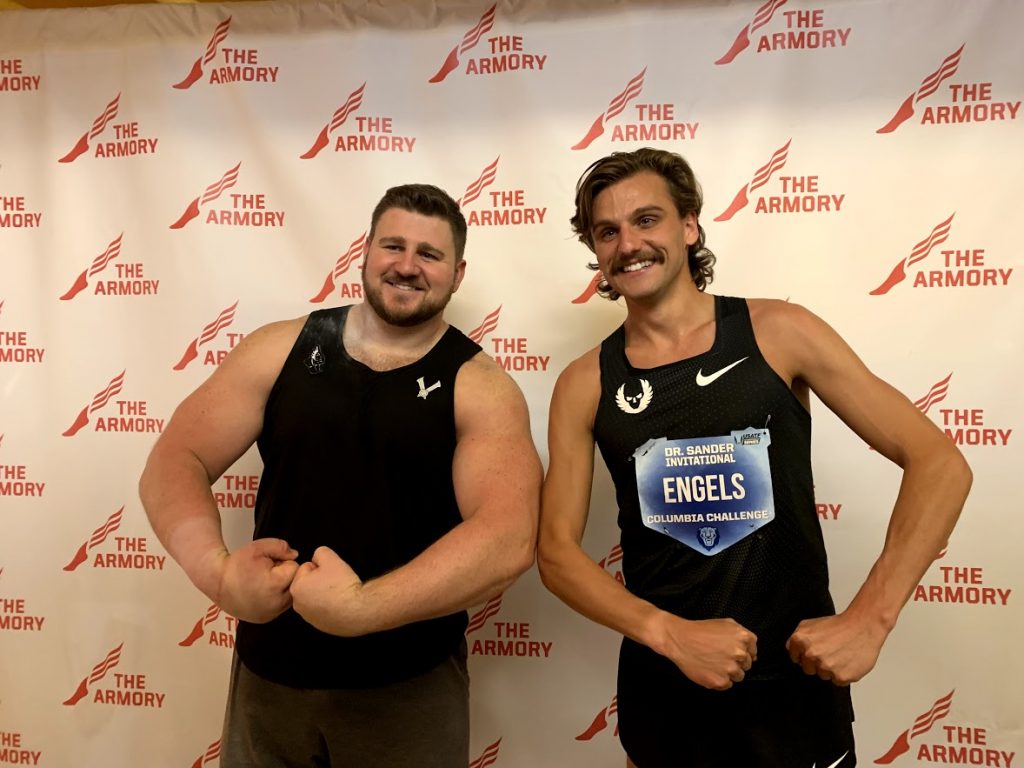 Joe Kovacs and Craig Engels Ham it Up in New York. Kovacs turned heads by talking about his dozen eggs a day diet.
Joe Kovacs and Craig Engels Ham it Up in New York. Kovacs turned heads by talking about his dozen eggs a day diet.
****
Recommended Read
Dominic Lokinyomo Lobalu Wants To Be The First Refugee Athlete To Win A Global Medal Lobalu fled South Sudan as a child during the civil war after being separated from his family. He has a 1500 best of 3:52 from London Worlds, but has been improving this year on the Kenyan XC circuit.
To see our favorite reads from other weeks, go here.
****
Quotes Of The Day And Last Week’s Home Pages
To see the quotes of the day from last week or last week’s home page or any home page, go to our archive page.
Got a tip, question or comment? Please call us at 844-LETSRUN (538-7786), email us or post in our forum.
